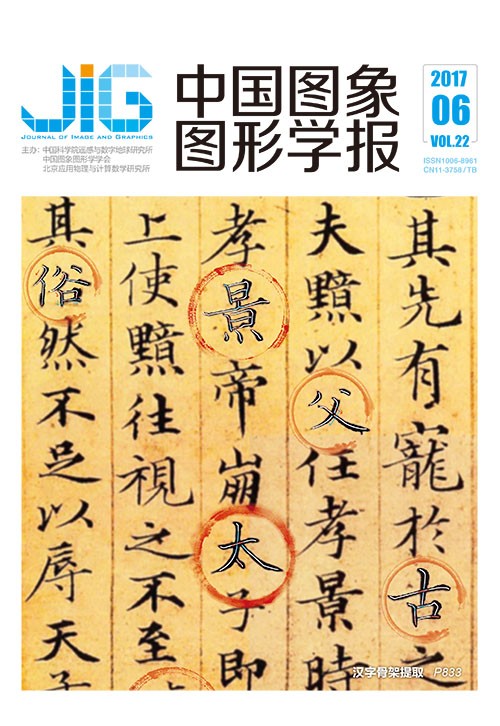
灰度序模式的局部特征描述算法
摘 要
目的 在针对LIOP(local intensity order pattern)特征描述算法构造特征描述符过程中,计算描述子权值时未充分考虑采样点之间的局部信息及存在冗余的灰度序模式,从而导致特征描述符不准确的问题,提出一种结合采样点结构信息和剔除冗余模式的算法。方法 首先,研究了采样点局部信息,并利用采样点顺序结构构造了计算特征描述符权值方法;其次,分析了灰度序模式与对应特征描述子权值的关系;最后,在构造特征描述符时,将冗余的灰度序模式剔除。结果 对标准数据集(Oxford dataset)及另外4幅复杂光照变化的图像进行了仿真实验,得到132维的特征描述符。结果表明,与原始LIOP算法相比,该算法在不增加特征维度时precision-recall曲线有较大的提高,即提高了描述特征描述符描述能力,增强了特征对单调强度变化和旋转变化的鲁棒性。结论 提出的算法同时考虑了采样点的差异信息和结构信息,较为完整地保留了待描述点的局部信息,使得图像存在复杂光照强度情况下,能够得到较高精度和辨识度的特征描述符。
关键词
Feature description algorithm based on the local intensity order pattern
Hu Jingshuang1, Nie Hongyu2(1.School of Information Science and Technology, Southwest Jiao tong University, Chengdu 611756, China;2.School of Rail Transit, Chongqing Vocational College of Transportation, Chongqing 402247, China) Abstract
Objective Image processing has been widely used in various fields due to the rapid development of computer vision. Accurate and robust image feature extraction is the premise of image analysis and recognition in image processing. Many state-of-the-art feature description algorithms are available, and local intensity order pattern (LIOP) is one of them. However, in existing feature description algorithms based on LIOP, the information between sampling points is not fully considered during weight calculation, and redundant intensity order patterns exist during the construction of the feature descriptor. These conditions result in an inaccurate feature descriptor. To solve this problem, an improved algorithm is proposed in this study. The algorithm maximizes the use of information between sampling points and eliminates redundant patterns.Method The LIOP algorithm shows that a feature descriptor is obtained by adding the weight of the index value of the corresponding order pattern. Therefore, the weight of each pattern affects the precision and accuracy of the feature descriptor, and the information on the sampling point is crucial. First, investigation of the local information of the sampling point indicates that the information on the local patch is not fully utilized, and redundant patterns exist. Therefore, an algorithm that calculates the weight of the feature descriptor is constructed by combining the order structure information of the sampling points. Second, with the increase in the sampling points, the patterns increase rapidly, and the dimension of the feature descriptor expands rapidly. These occurrences result in the curse of dimensionality. The relationship between the intensity order pattern and its corresponding weight is then analyzed. The contribution of the low-weight patterns is small when structuring the feature descriptor because these patterns are decided by the value of the sampling pixel points. High-weight patterns contribute significantly to the feature descriptor. Noise also causes the feature descriptor to become inaccurate. Analysis reveals the presence of redundant patterns, which need to be removed to make the feature descriptor reduction robust. Therefore, the redundant patterns are eliminated when constructing the feature descriptor. The obtained feature descriptor makes full use of local information and eliminates redundant patterns.Result The proposed algorithm is used to experiment on a standard dataset (Oxford Dataset) and four other complex illumination images. A total of 132 dimensional feature descriptors are obtained. Compared with the original algorithm of LIOP, the proposed algorithm can effectively improve the precision-recall curve and description ability without increasing the feature dimensions. In addition, the robustness of the feature descriptor is enhanced in terms of monotonic intensity and rotation change. Therefore, the improved feature descriptor demonstrates better performance than the original feature descriptor.Conclusion The proposed algorithm for constructing a feature descriptor makes full use of the difference and structural information between sampling points and eliminates redundant patterns. The performance and robustness of the feature descriptor are improved, and its dimension is reduced. The algorithm obtains high identification accuracy even under complex illumination.
Keywords
|



 中国图象图形学报 │ 京ICP备05080539号-4 │ 本系统由
中国图象图形学报 │ 京ICP备05080539号-4 │ 本系统由